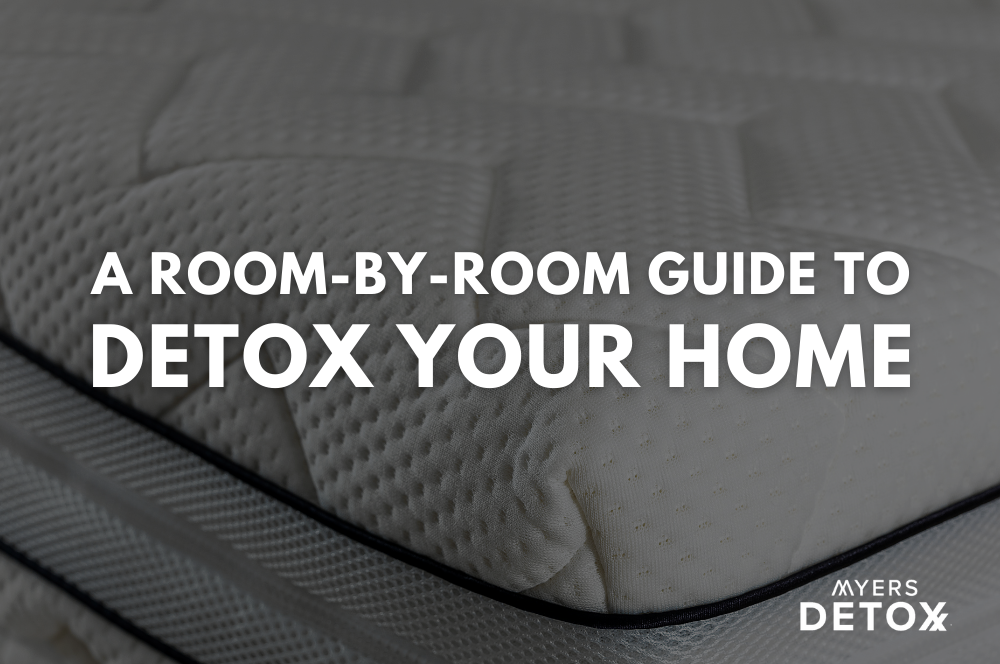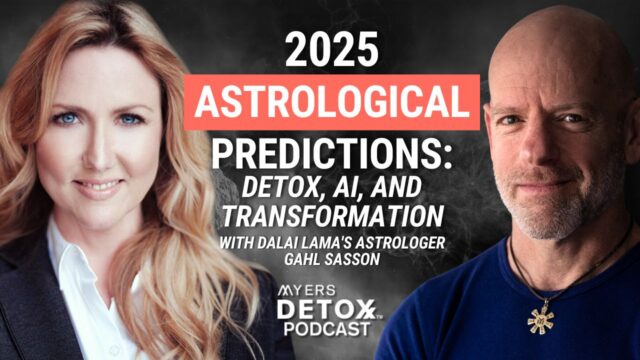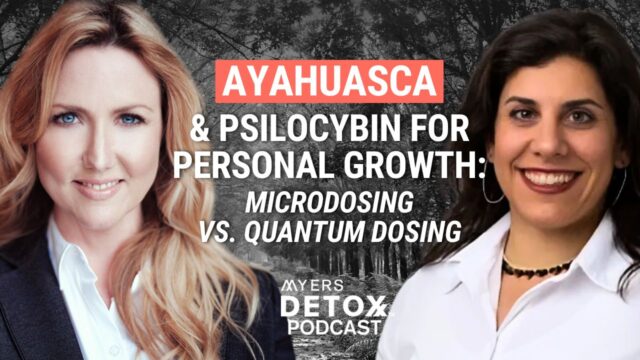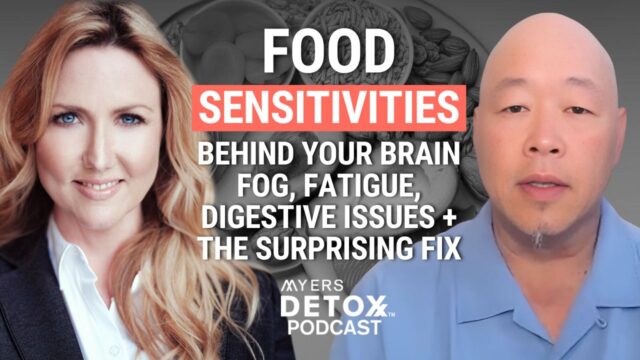Let’s talk about how to detox your home! While taking good care of your body has obvious benefits, we all too often overlook the importance of taking care of the health of our homes. Your home is where you likely spend the majority of your time, and it’s where you go to relax and reset. Unfortunately, the likelihood that you have unknowingly been living with toxins for years is pretty high.
Everything from cleaning supplies to air fresheners to cookware and beyond can be a source of toxic exposure. The sad truth is that the environment we live in today requires us to be diligent about our health – both from the inside and out.
In this article, we’ll walk you through your home, room by room, to highlight potential sources of toxins and what you can do about them. We’ll discuss:
- The hidden toxins in your kitchen that may be leaching into your food
- The toxic load of your bathroom – and why “clean” isn’t always clean
- Why your bedroom is one of the most crucial places to clean up
- Some practical ways to enhance the air quality in your home
Why It’s Important to Detox Your Home
Unless you live in a LEED-certified home in the middle of nowhere with all-natural textiles, dishware, and cleaning products – you likely have hidden chemicals in your home. This is no cause for alarm, but it is something you need to start paying attention to.
Cleaning up your home environment can be a significant task. That’s why I recommend going room by room and making a couple of changes at a time. You don’t have to do an entire overhaul in one day. However, if you do commit to cleaner living, you’ll find that in a short amount of time, the air in your home feels cleaner, you’ll likely be sleeping better, and if you’re someone who can sense the energy in your environment, it will feel much more fresh and alive.
So let’s dive in. We’re going to go room by room in your house to uncover hidden sources of toxins and how to remove them.
The Kitchen
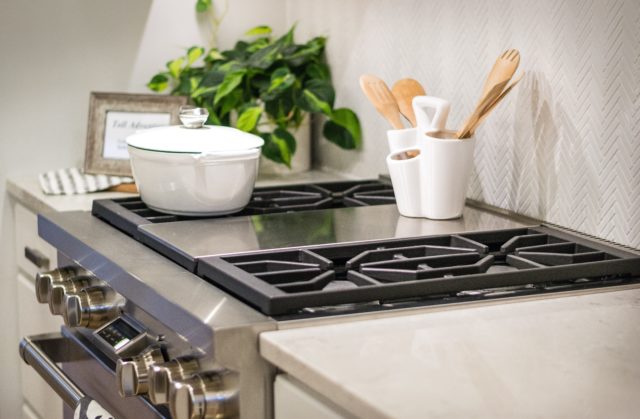
Your kitchen is the heart of your home. While you may have a dining room reserved for special occasions, the kitchen is your everyday space where you cook your meals, store your food, gather for conversation, and so much more.
It’s also one of the most vulnerable spaces in your house to toxic exposure. Being the source of food and drink in your home, when your kitchen is toxic, it makes it all that much easier for your food and beverages to become contaminated.
Here are some of the most common sources of toxic exposure in your kitchen:
#1 Cookware
You may be purchasing the highest quality food on the market, but if you’re cooking it in toxic cookware, your investment is pretty much out the window. The biggest culprit in toxic cookware is Teflon.
Teflon is the coating on your pots and pans that creates a non-stick surface. While this might make your cooking and cleaning experience a bit more seamless, Teflon is made from the chemical perfluorooctanoic acid (PFOA) and is highly toxic. When you cook your food with Teflon cookware, this compound can leach into the food and, ultimately, into your body.
When searching for safe cookware, avoid anything that carries the “Teflon” label or that markets itself as “non-stick.” Some companies make non-stick cookware that is Teflon-free, so you can keep an eye out for those. Otherwise, your safest bet is to go with healthier options like ceramic, glass, and stainless steel.
#2 Water
If you or your family members are in the habit of drinking water straight from the tap – you absolutely must stop. Our water supply is full of chemicals and contaminants, just a handful of which include[1]:
- Heavy metals
- Pharmaceuticals
- Disinfectants to kill microorganisms
- Bleach
- Bacteria
- Pesticides
- Radiological contaminants (cesium, uranium)
- And more
As you can see, filtering your water is absolutely crucial. Choosing a water filter can be a little tricky because there is a huge variety on the market, ranging from $20 to thousands of dollars. Unfortunately, many of the water filters on the cheaper end don’t really do much, they may filter out a contaminant or two, but they aren’t purifying your water thoroughly.
With that being said, you don’t have to shell out thousands of dollars for a high-quality filter. My personal favorite is Pure Effect Filters. These filters purify your water of all the above-mentioned contaminants (and more), and they’re very reasonably priced.
#3 Storage Containers
Most storage containers (Tupperware, plastic bags, etc.) are loaded with BPA (Bisphenol A). BPA is a chemical found in plastics, and it’s a known endocrine-disrupting hormone – with a special affinity for estrogen receptors.
While BPA can be found almost everywhere in our environment these days, the largest source of human exposure is food packaging. According to the Environmental Working Group, some of the health effects associated with BPA exposure include[6]:
- Brain, behavioral, learning, and memory impairment
- Cardiovascular abnormalities
- Diabetes
- Obesity
- Thyroid and sex hormone disruption
- Early puberty
- Changes to egg and sperm development and fertility
- Genetic alterations that can be passed on to future generations
To avoid BPA in your kitchen, swap out your plastic containers for glass ones, and look for paper bags for storage or brands with the label “BPA-free.”
Keep in mind that any packaged food you buy may also be wrapped in BPA linings, so avoid buying food-wrapped plastic as much as possible.
#4 Dishware and Water Bottles
Along the same lines as storage containers, plastic dishware you own may contain BPAs. Furthermore, unless your water bottles explicitly say “BPA-free,” you can be sure that there are BPAs in there. And that goes for both reusable water bottles as well as disposable ones.
With that being said, even products with a BPA-free label may be contaminated, so your best bet is to stick with ceramic, glass, or steel dishware and bottles.
#5 Canned Goods
Canned goods or food sold in tins is best tossed from your pantry altogether.
One obvious issue with canned goods is that they’re stored in a container that’s made of tin, which can leach into your food. To combat this issue, manufacturers add a “protective lining” to the tin, which is often made with BPA. In some cases, the protective lining wears away due to acidity or heat, and now you’ve got both BPA and tin leaching into your food.
When it comes to canned products, it’s really just a disaster waiting to happen. Some companies sell their products in a BPA-free canned container, but even in this case, it’s better to buy your food fresh or frozen.
#6 Aluminum Foil and Plastic Wrap
Every kitchen has that one drawer that’s stuffed with partially used aluminum foil and plastic wrap rolls. While these two items come in quite handy now and then, they really have no place in your kitchen – or your home, for that matter.
The obvious issue with aluminum foil is that, well, it’s aluminum. Aluminum foil is often used to wrap veggies on the grill or line a baking sheet, which means that the aluminum is not only touching your food but is undergoing extremely high temperatures as it does.
Aluminum is a toxic heavy metal that can impact several systems in your body and is associated with a variety of conditions, including (but not limited to) Crohn’s disease, inflammatory bowel diseases, anemia, Alzheimer’s disease, dementia, and autism[3][4].
And, of course, plastic wrap is yet another source of BPA.
In place of aluminum foil on the grill, try using cedar wraps. They’ll not only protect your veggies from the flame, but they’ll also provide a delicious cedar flavor. In place of plastic wraps, try using beeswax food wraps. These are non-toxic and can be molded around food just like a plastic wrap – minus the BPA.
Bathroom
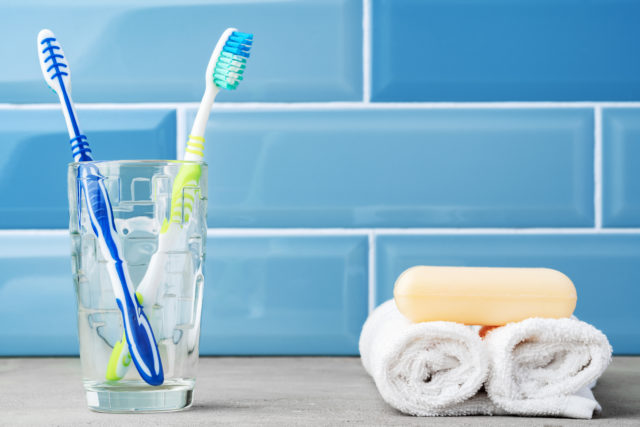
Your bathroom is a room where a lot of personal care happens. It’s also a room with a potentially significant amount of toxic exposure. Cleaning up your bathroom space goes beyond the obvious cleaning products and extends to your personal care products like moisturizers, makeup, soap, and so on.
Let’s get into it.
#1 Air Fresheners
Your plug-in air freshener or spray can make you feel like you’re cleaning up your home environment, but it’s actually doing the opposite. By nature of what these products are remade to do, their ingredients list contains a rather vague item called “fragrance.” This can sometimes also be labeled as “parfum.”
In either case, these labels are stand-ins for what could be any number of toxic chemicals that provide a pleasant smell. The International Fragrance Association (IFRA) lists 3,059 materials that are reported as being used in fragrance compounds. Of these various chemicals, resorts show that some have been linked to serious health concerns, including reproductive harm, endocrine system toxicity, and allergies[2].
What makes air fresheners so dangerous is that we frequently spray them without a thought, sometimes even out of habit. That could mean daily exposure to harmful chemicals right in your air supply.
Instead, try using products that are made with pure essential oils.
#2 Drain Cleaner
When your drains get clogged, drain cleaners like Drano is the go-to method for clearing up the mess. But have you ever wondered how these powerful cleaners are able to plow through whatever is clogging your drain to make it clear again? If you haven’t guessed, they do it with the help of highly toxic chemicals like lye and sodium hydroxide.
Instead, try a DIY method for clearing a clogged drain. The one that I’ve found to work best is as follows:
- Pull out the drain stopper and pour a pot of boiling water down the drain.
- Pour ½ cup of baking soda followed by ½ cup of vinegar down the drain.
- Allow the mixture to sit for 10 to 15 minutes
- Flush the drain with another pot of boiling water and run hot water from your tap for at least 30 seconds.
If that doesn’t do the trick, repeat the process a couple of times until your drain is running clear again.
#3 Bathtub and Shower Cleaner
A bathroom wouldn’t be complete without some type of cleaner to clear away the bathtub’s grime and scum. But unfortunately, most of the tile cleaners you find at the store contain ammonia. Why? Because ammonia does a fantastic job of breaking up fatty substances.
The problem is that although ammonia is very powerful, it’s equally toxic. Inhaling ammonia can cause severe irritation to the respiratory tract and potentially result in irreversible damage. It can also be very caustic when it comes into contact with your skin, causing burning or other forms of irritation. While most cleaning products don’t contain enough ammonia to burn your skin, it’s the long-term exposure via inhalation that’s really the concern[5].
Instead of using ammonia-based cleaners, take some time to find a non-toxic cleaner that suits your needs. Other chemicals to be aware of in common cleaning products include chlorine, bleach, and synthetic fragrances. When you go for a green-certified brand, you can rest assured that it’s been properly vetted. In a pinch, however, an equal mixture of vinegar and water can usually do the trick.
#4 Personal Care Products and Makeup
We can’t leave your bathroom without addressing two common sources of toxins; personal care products and makeup. These two categories deserve posts of their own, which is why I have written several detailed articles on the subject.
Without getting too nitty-gritty, it’s vital to understand that whatever you put on your body can be absorbed through your skin. If you only eat organic, high-quality food, it makes no sense to put toxic, low-quality products on your body.
Personal care and makeup products contain a range of harmful compounds, including (but not limited to):
- Heavy metals
- Phthalates
- Parabens
- Fragrance
- Formaldehyde
- Triclosan
- Ethanolamine Compounds (DEA and TEA)
- Dioxane
- And many, many more
Unless your products explicitly state that they are free of unwanted chemicals, you can be sure that they’re contaminated.
One brand that I trust and respect for cosmetics and personal care is Annmarie Skin Care. Annmarie Skin Care uses organic ingredients that are sustainable, cruelty free, and non-GMO. Each of their products is specially crafted with the highest-quality ingredients for effectiveness and safety.
#5 Mold Cleaner
Mold is a toxic issue in and of itself, but when it comes to getting rid of mold, we have another problem – toxic mold killers. Now, if you have a serious mold problem, it’s time to call in the professionals because trying to take care of mold on your own could only cause more issues.
With that being said, we’ve all seen little patches of mold show up in the corner of our shower or windowsill now and then. One of the best treatments for spotty mold is simply spraying some white vinegar on the area. Add your white vinegar to a spray bottle (undiluted), spray the area, and then let it sit for about an hour. Come back after an hour and wipe the area clean and dry.
Living Room and Bedroom
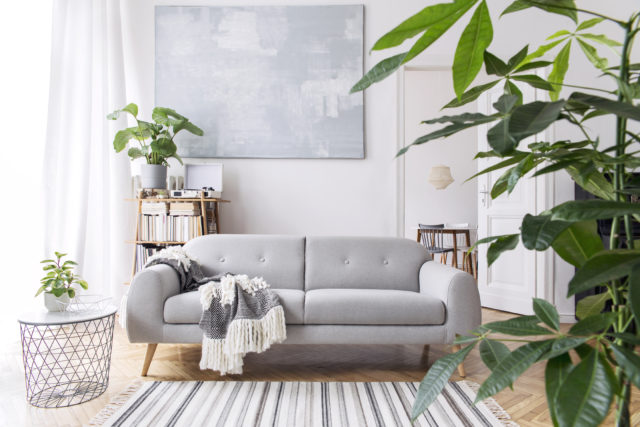
Much like the bathroom, you’ll want to make sure the cleaning supplies you use in your living room and bedroom are also green-certified and completely toxin-free. You’ll also want to avoid the use of air fresheners in these spaces. In addition, there are a handful of specifics to keep in mind for your living room and bedroom.
#1 Air Quality
Most people don’t realize that the air in their homes can be filled with toxic compounds. In fact, indoor air can be up to five times more toxic than outdoor air.
Of all of the potential chemicals in your air, formaldehyde is the most common indoor pollutant in homes today. It can come from a variety of sources, including gas stoves, household products, building materials, and more.
Formaldehyde is dangerous on its own, but when it breaks down, it can form carbon monoxide, which can be deadly.
Investing in a high-quality air filter is one of the best things you can do for the health of everyone in your family. With that being said, it can get expensive to put a filter in every single room in your home, so if you have to choose – go with the bedroom.
Although you’re mostly unconscious, this is the room you spend the majority of your time in. For most people, that’s at least eight hours a day, and often more. Therefore, if you can keep the air in your bedroom clean, you’re doing your body a big favor for at least one-third of your day.
I use Air Doctor. I also love Breathe Safe from Creatrix Solutions, a portable and compact personal air purification system that generates millions of negative ions, balanced by a small number of positive ions, as soon as it’s connected.
You can also fill your home with detoxifying plants for enhanced air quality. There are certain plants that can suck pollutants right out of your air. These include the Garden Mum, Peace Lily, Aloe Vera, and the Spider Plant.
#2 Remove Foam Furniture
Foam mattress covers may offer a soft, cloud-like sleeping experience, but these materials are treated with fire retardants that off-gas toxic chemicals that you breathe in all night. It does little good to have a high-quality air filter if you’re sleeping on a toxic mattress.
The same goes for your living room furniture, such as sofas and armchairs. If they’re made with foam, you can be sure they were sprayed with fire retardants.
When possible, choose furniture made with leather, wool, cotton, or wool.
#3 Check For Lead Paint
If your home was built before 1978, there’s a good chance you have lead paint lurking on those walls. Paint slowly deteriorates over time, which means that you may be inhaling dust that contains lead particles on a daily basis.
Lead poisoning is extremely serious, especially for the little ones. Exposure to this heavy metal can cause a range of issues, most strikingly mental and physical development. Children exposed to lead may experience developmental delay, learning difficulties, irritability, fatigue, weight loss, and more.
You can remove your lead paint using a wet sanding method with a HEPA filter vacuum. But it’s probably best to hire a professional to do this job, so you don’t expose yourself to unnecessary toxicity.
Laundry and Other Cleaning Practices
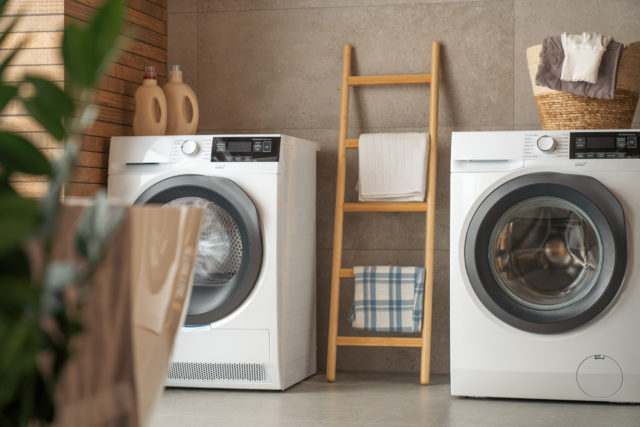
There are a few standard cleaning regimens that every household follows. Namely, laundry, vacuuming, and (hopefully) dusting. While these practices themselves are great for keeping your home clean and reducing toxins, there are certain practices you should follow to make sure you’re getting the most out of your time.
#1 Laundry Detergent
Similar to how personal products can contain chemicals that absorb into your skin, chemicals in laundry detergent that get absorbed into your clothes can also end up in your skin – and eventually in your body.
Remember, anything that touches your skin has the potential to absorb into your circulation.
You wear your clothes every day, which is why purchasing toxic-free laundry detergent is so crucial.
Some of the biggest offenders in laundry detergents include benzene, nonylphenol ethoxylates, Dioxane, and fragrance. These harmful chemicals are linked to hormone imbalance, endocrine disruption, respiratory dysfunction, and more.
My personal favorite laundry detergent is Truly Free. This product is not only toxin-free, but it comes in refillable jugs, so you’ll also be doing the planet a favor.
#2 Vacuum
No one likes vacuuming, but we all have to do it. I recommend finding a vacuum model equipped with a HEPA filter to get the most out of your vacuum. A HEPA filter (“high-efficiency particulate air” for short) is a mechanical air filter that traps harmful particles like mold spores, pollen, pet dander, and dust mites.
This will ensure that any of the toxins from your air that settle into your carpet or in the corners of your home will be swept away once and for all.
#3 Dusting
While vacuuming is often something that comes naturally as we notice our floors looking like they could use some help, dusting is something that many people put off.
What you may not realize is that household dusk contains a multitude of toxins that can build up and add to your air contamination. A handful of dust’s toxic compounds include fungal spores, phthalates, flame retardants, phenols like bisphenol A (BPA), Perfluorinated chemicals (PFCs), and fragrance chemicals.
Therefore, it’s a good idea to make dusting a part of your regular routine, along with vacuuming.
Takeaway
If you’re a health-conscious person (which, if you’re reading this, you probably are), then caring for the health of your home must become a priority right up there with caring for the health of your body.
As much as a healthy diet and exercise regimen will do your body good, you don’t live in a vacuum, and the world around you directly impacts your physical health.
Now, if you’re reading this article and feeling a little overwhelmed, take a deep breath and rest assured that none of these suggestions need to be done this instant. Cleaning up your home environment is a project; it can take several months or even years to complete for some people.
With that being said, the more you can do today, the better you’ll feel tomorrow. I suggest taking a couple of suggestions at a time and making changes slowly but progressively. Truly, any changes you make toward a less toxic home will pay off.


